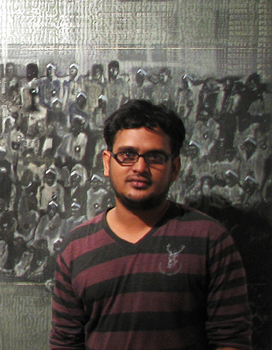|

Born in 1980, Balaji Ponna received his B.F.A in Graphics
from Andhra University with Gold medal and M.F.A in Graphics from Visva
- Bharati University, Santiniketan. He has been recipient of H.R.D.
National Scholarship for young Artists (2004–05). His recent solo
exhibitions include Looking is not Seeing, at The Guild, Mumbai;
Monuments at India Art Summit 2011 with The Guild, Mumbai; The
Things I Say, at Studio La Citta, Verona and Black Smoke, at
Bose Pacia, Kolkata, in collaboration with The Guild. Ponna has
participated in various group shows over the last couple of years
including Art Celebrates 2010: Sports and the City, an
Exhibition of Indian Contemporary Art curated by Rupika
Chawla; Contemporary
Exoticism curated
by Marco Meneguzzo at Studio
La Citta, Verona; Art Basel by Studio la Citta, 2009; A New
Vanguard: Trends in Contemporary Indian Art, Saffronart, New
York and The Guild, New York; The July Show at The Guild and Are
We Like This Only? Curated by Vidya Shivadas at Vadehra Art Gallery
, Delhi . His works were also exhibited at the France Print Biennial in
2009.
“Responding to the socio-political and cultural realities
of the time is one of the modes in which artists engage thematically
through work. Within this engagement there are several trajectories of
expressions that had emerged corroborating the subjective experiences of
the artist in relation to the objective existence in society….
Balaji’s works comprise a crucial
relation between the painted text-phrases and the images. In fact this
text, composed in two phrases, frames the meanings and the subtext of
the visual images. Written in a simple typography, this text does not
intervene in the picture format but stays on the surface, by virtue of
its flat, two-dimensional nature. In one sense this text is equal to the
status of parergon, as theorised by Derrida – Parergon is
“neither work (ergon) nor outside the work, neither inside or outside,
neither above nor below, it disconcerts any opposition but does not
remain indeterminate and it gives rise to the work” (Truth in
Painting, 1978). The textual phrase belongs to the work (painting)
as well as stays unrelated pictorially to the painting. When a viewer
approaches these paintings, the sight is drawn towards deftly manoeuvred
images, but quickly, the verbal text catches the eye, as if intervening
between the pictorial image and the sight of the onlooker. This moment
of rupture is also the moment of introduction of specific meanings to
the work. The phenomenological and aesthetic experience of the viewer,
in this context, is guided by the text-phrase, written in English. And
in this moment of quick shifts between the textual phrase and the image,
signification gets complicated and acquires a double signification which
correlates each other – the text and the image. At one level the
text-phrase puts forward a literal or direct meaning of it. When the
signified or the meaning interacts with the image, this signified
becomes empty and acquires a second level signification, whose signified
belongs to the social and political realms.” (Excerpt from an essay by
Santosh Kumar Sakhinala)
“Balaji takes images from different eras and sources and
put them in the contemporary context of viewing in a gallery as a
painting. His paintings are ‘anachronic’. By saying this I am referring
to the popular signboard/billboard techniques and philosophy. These
popular signs significantly underplay/undermine what is ‘high brow’. The
practitioners uninhibitingly draw references and images from any source
which they feel would suit their need making them “anachronic”. By
juxtaposing and overlapping images from divergent sources which
necessarily have no relation they break the linearity of the process and
the order (even copyrights and patent laws). In a similar way, Balaji
also draws reference from multitude of sources which necessarily are not
related and puts them together in his works. His works are also
‘anachronic’ because of his persistence with the idea of nation and
nationalism. When even the idea of nation itself is collapsing before
the power of ‘capital’, Balaji attempts to play the same rhetoric with a
possibility of offering a glimmer of hope relying on the past. Capital
has the power to break all virtual boundaries either by negotiating in
the adversaries’ guise or overtly colonialising by force. But Balaji
undermines this power by opting for a similar version of democratic
change. Often his works pokes the system’s inconsistencies with pun and
sarcasm. But interestingly these also refer to the popular/ist
ideologies in circulation defining betterment and emancipation. Balaji’s
recent take on the concept of nationalism brings through his beliefs
on the democratic system and a possibility of reformation within
the same order. By remembering an imaginary past of political
and social ethicality he attempts to visualize a better possibility.”
(Except from an essay by V. Divakar) |
|
|
|